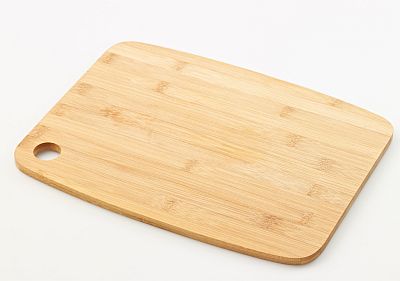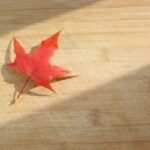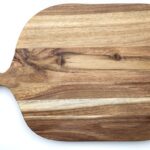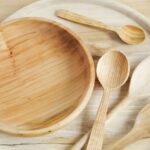Bamboo cutting boards are extremely strong and are more resistant to damage than wooden boards. Bamboo utensils are also thought to be safer and more hygienic than wooden ones because bamboo does not absorb liquids easily and has mild natural antimicrobial properties.
To extend the life of your bamboo board and to keep it looking new, make sure to follow the manufacturer’s instructions for cleaning and care. Generally, bamboo cutting boards don’t require a lot of maintenance to retain their functionality and beautiful appearance.
Here are some basic tips for proper care of bamboo cutting boards.
1. How to Condition Condition a Bamboo Cutting Board Before Use
You need to seal and condition your new and untreated bamboo board with food-grade mineral oil before its first use. Apply the oil to a clean rag and rub thoroughly across your board. Place the board in an upright position and leave it overnight to let the oil set. Oil coating creates a protective seal that repels water, prevents splitting, and gives a beautiful, smooth finish.

2. Washing
Never put your bamboo cutting board in the dishwasher because the heat will damage the protective oil coating and the board may come out warped. Soaking the board in water for washing can also lead to warping.
To prevent staining, it is recommended to clean the board immediately after use. Use a spatula to scrape off the food waste, then wash the surface with mild dish soap and water. Make sure that the board isn’t exposed to water longer than necessary. Rinse off under hot running water and dry it well with a clean dishtowel. Then, place the board in an upright position and allow it to air dry for a few hours.
3. Cleaning Stubborn Stains
Do not use chemical cleaning agents to clean food stains from a bamboo cutting board. To remove stains from brightly colored foods, use coarse salt or baking soda. There are two basic ways to do that:
1) Cover the stained area with coarse salt. Rub the salt into the stain using a wet cloth or sponge. Add more salt and repeat the process until the stain is gone.
2) Sprinkle the stain with baking soda and rub it with a damp cloth. Let the paste sit for a few minutes, then rinse and towel dry your cutting board.
4. Deodorizing
To deodorize a smelly cutting board, sprinkle salt on it and squeeze half of the lemon while rubbing it across the surface. Leave the mixture on the board for at least 2 hours to allow the lemon and salt to penetrate the surface and counteract smells. Rinse and towel dry the board with a clean cloth to remove excess moisture and let it air dry.
5. Disinfecting
Although bamboo has mild antiseptic properties, you need to disinfect your board periodically. Plus, your cutting board needs to be sanitized every time it comes in contact with raw meats, poultry, and seafood. To minimize the risk of cross-contamination, use separate cutting boards for raw meats and other foods.
White vinegar is a natural cleaner and disinfectant with solid antimicrobial properties. Soak a cloth in a solution of vinegar and water (one-to-one ratio) and rub it over the board. Spread some baking soda over it. Use a sponge to scrub the stains. Allow the mixture to sit for a few minutes, then rinse the board and wipe with a dishtowel.
Another option for sanitization is using a 3% hydrogen peroxide solution, which is non-irritant, environmentally friendly, and works well as a surface disinfectant.
Do not put vinegar with hydrogen peroxide in the same bowl or apply to the same towel, as these ingredients will interact, forming a base.
Once completely dried, treat the board with mineral oil.
You can also use earth-friendly, organic Castile-based soap, which is formulated without harmful additives to clean and sanitize bamboo or wooden utensils in one step.
Don’t put your bamboo cutting board in the microwave to disinfect it because overheating would damage the cutting board.
6. Restoring
To restore a dried-out cutting board, use a sheet of fine sandpaper to re-sand the finish and make the surface smooth again. Clean all the dust and wash the board with hot, soapy water. Allow it to dry completely and then re-coat the bamboo with mineral oil.
To fix a warped cutting board, submerge it in warm water for a couple of hours. Lay it on a flat surface and place another flat object over it. Place a heavy object on top (or several heavy objects) to flatten the board.
7. Oiling Bamboo Cutting Boards
To recondition your old and dry cutting board, you need to treat it with oil. This treatment helps maintain a nice luster and prevents the bamboo from drying out and developing cracks. Apply a food-grade mineral oil once or twice a month to revitalize bamboo and keep the shine. Using cooking oils to condition your board is not recommended because these oils are less shelf-stable than mineral oil and will turn rancid.
Pour some pure mineral oil out onto the surface and use a tightly woven soft cloth to spread the oil all over the board. Apply the oil in the direction of the grain if possible or in a circular motion if the grain goes in multiple directions. Place your treated board aside for at least one hour to let the oil soak in. Wipe off the excess oil with a clean cloth before storing.
Repeat the process once or twice a month or when your board looks dry and discolored. Once the bamboo is saturated with the oil, you’ll need to condition it less frequently.
Some conditioning products use food-grade mineral oil combined with natural waxes. This combination can make the board more water and stain-resistant than using plain mineral oil. The viscosity of the bee’s wax makes the product easier to apply to the board. These cutting board conditioners absorb the bamboo/wood better when warmed up before application.
If you are looking for a natural formulation without synthetic additives, Bartow and Sons Vegan Cutting Board Oil could be a good choice. This vegan formulation is made from treated coconut oil and essential citrus oil. Bartow Board Oil is refined to ensure that the oil will not go rancid or impart smells and tastes.
8. Storage
Hang or store your bamboo cutting board in a dry and cool place where the air can circulate. To keep the board away from extreme heat, don’t place it next to the stove or in other hot areas. Don’t place the pans removed from the stove and other hot items on top of the board. To minimize the risk of bending, store your clean and dry cutting board horizontally. To prevent mold growth, do not put it in the basement or other areas in the house with high humidity.





Seasoning and sealing? This is hilarious because no one in Asia does any of this, and we keep our cutting boards, whether wood or bamboo, for decades. Heck, bamboo ware originated in Asia so we’re not exactly inexperienced. Just scrub and clean them along with the pans and dishes. The boards may not look pretty but they do their job and we save so much time and money on cleaning and maintenance. As for looking pretty, some of us have a separate board as a serving surface, e.g. a western style cheese board.
fantastic!
just as this elderly ozzie g mum does… I’m still using my g ma’s cutting boards and we don’t get sick from either the anti-bacterial/microbial old wooden or the new bamboo.